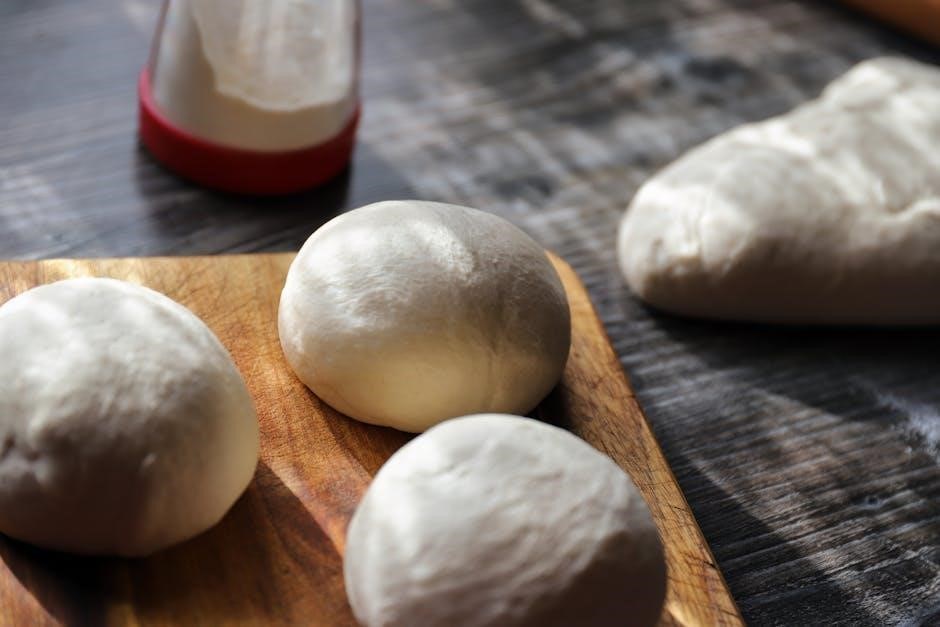Oster Bread Machine Recipes PDF: A Comprehensive Guide
Discover a treasure trove of culinary delights with our comprehensive guide to Oster bread machine recipes in PDF format! From basic loaves to specialty breads, we’ll help you unlock the full potential of your Oster bread maker.

Finding Oster Bread Machine Manuals and Recipes Online
Embark on a digital quest to locate Oster bread machine manuals and recipes online! The official Oster website stands as a primary resource, often hosting downloadable manuals and recipe booklets tailored to various models. Supplementing this, explore free websites offering PDF downloads of manuals and instructions, providing a wealth of information at your fingertips.
Delve into online forums and communities dedicated to bread machine enthusiasts. These platforms often share recipes, tips, and troubleshooting advice, creating a collaborative space for bakers of all levels. Consider exploring online libraries and archives for scanned versions of older manuals and recipe books, offering a glimpse into the history of Oster bread machines.
When searching, specify your Oster bread machine model number for targeted results. Utilize search engines effectively, employing keywords such as “Oster bread machine manual PDF” or “Oster bread machine recipes.” Remember to verify the credibility of sources before downloading any files to protect against malware or inaccurate information. With diligent searching, you can unlock a wealth of resources to enhance your Oster bread-making journey.
Understanding Oster Bread Machine Models and Settings
To master the art of bread making with your Oster machine, a thorough understanding of its models and settings is essential. Each Oster bread machine boasts unique features and functionalities. Familiarize yourself with the control panel, paying close attention to the various cycle options, such as basic, whole wheat, French, sweet, and quick bread.
Explore the crust control settings, allowing you to customize the browning level of your loaf. Delve into the delay start function, enabling you to program the machine to begin baking at a later time, ensuring freshly baked bread upon your return. Consult your Oster bread machine manual for a comprehensive overview of all available settings and their specific applications.
Experiment with different settings to discover your preferred bread textures and flavors. Note that certain models may offer specialized settings, such as dough-only cycles for pizza or pasta. By understanding the nuances of your Oster bread machine, you can unlock its full potential and create a wide array of delectable baked goods. Don’t forget to factor in altitude adjustments if you live in a high-altitude location!
Basic Bread Recipes for Oster Bread Machines
Embark on your bread-making journey with these fundamental recipes tailored for Oster bread machines. A classic white bread recipe serves as an excellent starting point. Combine bread flour, water, sugar, salt, and yeast in your bread machine pan, following the order specified in your manual. Select the basic bread cycle and your desired crust color.

For a heartier option, explore whole wheat bread recipes, substituting a portion of the bread flour with whole wheat flour. Adjust the liquid content as needed, as whole wheat flour tends to absorb more moisture. Consider adding vital wheat gluten to enhance the bread’s structure.
Experiment with variations by incorporating herbs, seeds, or cheese into your basic dough. Remember to measure ingredients accurately for consistent results. Always use bread machine yeast for optimal rising. Monitor the dough during the kneading process, adjusting liquid or flour as necessary to achieve a smooth, elastic consistency. With a little practice, you’ll master the art of basic bread making in your Oster machine. Store your freshly baked bread in an airtight container to maintain its freshness.
Specialty Bread Recipes: Cinnamon Raisin Bread
Indulge in the warm, comforting aroma of homemade cinnamon raisin bread, effortlessly crafted in your Oster bread machine. Begin with a basic sweet dough recipe, incorporating ingredients like bread flour, milk, butter, sugar, eggs, and yeast. Once the dough has undergone its initial kneading and rising, gently fold in a generous portion of cinnamon and raisins.

For an enhanced flavor profile, consider soaking the raisins in warm water or rum prior to adding them to the dough. This will plump them up and infuse them with extra moisture. When adding the cinnamon and raisins, ensure they are evenly distributed throughout the dough to prevent clumping. Select the sweet bread or dough cycle on your Oster bread machine, depending on your desired outcome.
If your machine has a fruit and nut dispenser, utilize it for automatic addition of the cinnamon and raisins. After baking, allow the bread to cool completely before slicing and serving. Enjoy it toasted with butter, as a delightful breakfast treat, or as a sweet accompaniment to your afternoon tea. Feel free to experiment with other dried fruits and spices to create your own unique variations.
ExpressBake Recipes: Tips and Tricks
Master the art of quick bread making with Oster’s ExpressBake setting! This rapid cycle demands precision. Always use bread machine flour for optimal gluten development, ensuring a well-structured loaf in a shorter time. Hot water, between 115-125°F, is crucial for activating the yeast rapidly. Add ingredients in the order specified by your recipe.
Liquid first, then dry, with yeast last, nestled in a well atop the flour. This prevents premature activation. Monitor the dough’s consistency during the initial mixing. If it appears too dry, add water one teaspoon at a time. If too wet, add flour similarly. Remember, ExpressBake is sensitive to ingredient ratios.
Avoid recipes requiring extensive rise times. Opt for those designed specifically for quick cycles. Keep a close eye on the bread during baking. Due to the accelerated process, it can brown quickly. If necessary, tent the top with foil to prevent over-browning. Once done, remove the loaf immediately to cool, preventing a soggy bottom. Embrace experimentation, but stick to tested ExpressBake recipes for best results.
Yeast Considerations for Oster Bread Machines
Yeast is the heart of bread making, and understanding its role is vital for success with your Oster bread machine. Active dry yeast, instant yeast (also called bread machine yeast), and fresh yeast are the primary options. Instant yeast is generally preferred for bread machines due to its reliable rise and ease of use. Unlike active dry yeast, it doesn’t require proofing.
Always check the expiration date on your yeast packet. Stale yeast can lead to flat, dense loaves. When adding yeast to the bread machine, ensure it doesn’t come into direct contact with liquids, especially if using the delay start function. A small well in the flour is ideal. The amount of yeast is crucial; too little results in a dense loaf, while too much can cause the bread to collapse.
Adjust yeast quantities based on environmental conditions. In humid weather, slightly reduce the yeast to prevent over-proofing. Consider using a sourdough starter for a tangy flavor. However, this requires adjustments to liquid and flour ratios. Experiment to discover your preferred yeast type and quantity for optimal results.
Flour Selection for Optimal Results
The type of flour you choose significantly impacts the texture and structure of your bread when using an Oster bread machine. Bread flour, with its higher protein content, is generally recommended for most recipes. This higher protein develops more gluten, resulting in a chewier, more elastic crumb and a better rise. All-purpose flour can be used, but the bread may be slightly less structured.
Whole wheat flour adds a nutty flavor and increased fiber, but it can also make the bread denser. When using whole wheat flour, consider combining it with bread flour to achieve a balanced texture. For gluten-free baking, specific gluten-free flour blends are necessary. These blends often contain a mix of rice flour, tapioca starch, and potato starch, along with a binding agent like xanthan gum.
Always measure flour accurately, preferably using a kitchen scale for consistent results. Avoid packing the flour when measuring with cups, as this can lead to dry, dense bread. Store your flour in an airtight container in a cool, dry place to maintain its freshness and prevent it from absorbing moisture, which can affect its performance in your Oster bread machine.
Troubleshooting Common Bread Machine Issues
Encountering issues with your Oster bread machine? Let’s troubleshoot some common problems. If your bread isn’t rising, check the yeast. Ensure it’s fresh and hasn’t expired. Also, verify that the water temperature is correct—too hot or too cold can inhibit yeast activity. Another culprit could be insufficient gluten development. Make sure you’re using the right type of flour, like bread flour, and that you’ve measured the ingredients accurately.
If the bread is too dense, it might be due to too much flour or not enough liquid. Conversely, if the dough is too sticky, you may have added too much liquid. Adjust the ingredient ratios accordingly in your next attempt. A collapsed loaf can result from too much yeast or too warm of an environment.
Sometimes, the kneading paddle may get stuck. Ensure it’s properly installed before starting the machine. If the bread is burning on the outside, try reducing the baking time slightly. Regularly cleaning your Oster bread machine and following the manufacturer’s instructions can also prevent many common issues.
Sweet Bread Adaptations for Oster Machines
Adapting sweet bread recipes for your Oster bread machine opens up a world of delicious possibilities. Start by selecting recipes that are specifically designed for bread machines, as they account for the machine’s unique baking environment. When adapting traditional recipes, remember that Oster bread machines typically excel with yeast-based doughs rather than quick breads that rely on baking powder or baking soda.
To enhance the sweetness, increase the sugar content slightly, but be mindful of the machine’s capacity. Adding ingredients like dried fruits, nuts, or chocolate chips can elevate the flavor and texture of your sweet bread. Incorporate these additions during the machine’s designated mixing phase, usually after the initial kneading.
Experiment with flavors like cinnamon, vanilla extract, or citrus zest to create unique sweet bread variations. Glazes or icing can be added after baking to further enhance the sweetness and presentation. Always monitor the dough’s consistency and adjust liquid or flour levels as needed to achieve the desired result. Remember, practice makes perfect, so don’t be afraid to experiment and find your favorite sweet bread adaptations for your Oster bread machine.
Oster Bread Machine Maintenance and Care
Proper maintenance and care are essential to prolong the life of your Oster bread machine and ensure consistent baking results. After each use, unplug the machine and allow it to cool completely before cleaning. Remove the bread pan and kneading paddle, washing them with warm, soapy water. Avoid abrasive cleaners or scouring pads, as they can damage the non-stick coating.
Wipe down the interior and exterior of the bread machine with a damp cloth. Ensure that all parts are completely dry before reassembling. Regularly check the heating element for any food debris and gently remove it with a soft brush. Periodically inspect the power cord for any signs of damage and replace it if necessary.
Store your Oster bread machine in a cool, dry place when not in use. Avoid storing it in areas with high humidity or extreme temperatures. By following these simple maintenance and care tips, you can keep your Oster bread machine in top condition and enjoy years of delicious homemade bread. Remember to consult your user manual for specific cleaning and maintenance instructions for your model.
Converting Traditional Recipes for Bread Machines
Adapting your cherished traditional recipes for use in an Oster bread machine can be a rewarding experience, allowing you to enjoy homemade goodness with the convenience of automation. However, it requires careful adjustments to ensure optimal results. The key lies in understanding the ratios and limitations of your bread machine.
Start by reducing the liquid content by about 20% to compensate for the bread machine’s enclosed environment. Accurately measure all ingredients using a kitchen scale for consistent outcomes. When adding ingredients to the bread pan, follow the order recommended in your Oster bread machine manual, typically starting with liquids, followed by dry ingredients, and yeast last, placed in a well on top of the flour.
Monitor the dough during the kneading process; it should form a smooth, elastic ball. If the dough is too wet, add flour one tablespoon at a time; if it’s too dry, add water in small increments. Select the appropriate bread machine cycle based on the type of bread you’re making (e.g., white, whole wheat, sweet). Keep detailed notes of your adjustments to refine the recipe for future batches.
PDF Resources for Oster Bread Machine Recipes
Unlocking a world of culinary possibilities is easier than ever with readily available PDF resources for Oster bread machine recipes. These digital repositories offer a wealth of information, from basic bread recipes to more complex and creative variations. Many Oster bread machine manuals, often found online as PDF downloads, include a dedicated section of recipes specifically tailored for their models.
Websites dedicated to bread machine baking also host numerous PDF recipe collections, often categorized by bread type, dietary restrictions, or skill level. These PDFs frequently include detailed ingredient lists, step-by-step instructions, and helpful tips to ensure successful baking. Furthermore, online forums and communities dedicated to bread machine enthusiasts often share their own tried-and-true recipes in PDF format.
Before downloading any PDF, ensure that it originates from a reputable source to avoid potential inaccuracies or safety concerns. Always cross-reference recipes with other sources or your Oster bread machine manual to confirm ingredient quantities and baking times. With a little searching, you can amass a comprehensive library of PDF recipes to elevate your Oster bread machine baking.
Advanced Techniques for Bread Machine Baking

Elevate your bread machine baking skills beyond basic recipes by exploring advanced techniques that unlock new flavors and textures. One such technique involves pre-ferments, where a portion of the flour and water is mixed with yeast and allowed to ferment before adding it to the main dough. This enhances the bread’s flavor complexity and improves its keeping quality.
Experiment with different flour combinations to achieve desired results. Incorporating whole wheat, rye, or spelt flour can add depth of flavor and nutritional value to your loaves. However, adjust the hydration levels accordingly, as these flours tend to absorb more water than all-purpose flour.
Master the art of adding inclusions like nuts, seeds, dried fruits, or herbs at the appropriate stage of the baking cycle to prevent them from being crushed or over-mixed. Consider using the dough cycle to create pizza dough or other specialty doughs, then shape and bake them in a conventional oven for a superior crust.
Finally, explore the possibilities of using the bread machine as a kneading tool for no-knead bread recipes, allowing for a longer, slower fermentation process that results in exceptional flavor.
